Evaluating a Simple Algorithm for an Evapotranspiration Retrieval Energy Balance Model in Mediterranean Citrus Orchards
Abstract
1. Introduction
2. Materials and Methods
2.1. Study Site
2.2. EC Footprint Analysis
2.3. Description of the SAFER Model
2.4. Model Calibration and Validation
- (i)
- EC data (at 30 min resolution) and H, LE, Rn, G data from the Lentini tower (Section 2.1) were quality-controlled following standard practice (spike removal, tilt correction, frequency-response, and WPL density corrections), screened by nighttime u⋆ thresholds, and aggregated to daily values when data coverage ≥ 80%. Energy-balance closure was monitored as EBC = (H + LE)/(Rn − G); days with poor closure were flagged and excluded from calibration but kept for sensitivity checks.
- (ii)
- Meteorological records from SIAS provided daily (FAO-56 Penman–Monteith) and auxiliary variables.
- (iii)
- Sentinel-2 MSI images (cloud-masked and atmospherically corrected) supplied , NDVI, and the variables needed for Equations (1)–(8); only scenes with cloud cover ≤10% over the footprint were retained. All satellite quantities were extracted as the footprint-weighted mean within the 50–90% EC footprint contours for each date.
2.5. Additional Performance Metrics
Validation Metrics
3. Results
3.1. Footprint Analysis
3.2. Calibration
3.3. Model Validation Results
Model Validation with Error Metrics
4. Discussion
- Integration of physiological crop indicators to account for drought-induced transpiration reduction.
- Coupling with soil moisture sensors or remote sensing of surface wetness to detect water deficits.
- Phenological modeling to capture seasonal shifts in canopy function, particularly in evergreen species like citrus.
- Expansion of calibration efforts across different orchard systems to develop region-specific coefficients.
5. Conclusions
Author Contributions
Funding
Data Availability Statement
Acknowledgments
Conflicts of Interest
References
- Liu, Y.; Chen, R.; Han, C.; Liu, Z.; Zhao, Y.; Yang, Z. Research on the Characteristics, Driving Mechanism and Spatial Pattern of Carbon Sink in Alpine Ecosystem: A Study Case of Qilian Mountains. Agric. For. Meteorol. 2024, 356, 110166. [Google Scholar] [CrossRef]
- Kang, M.; Cho, S. Progress in Water and Energy Flux Studies in Asia: A Review Focused on Eddy Covariance Measurements. J. Agric. Meteorol. 2021, 77, 2–23. [Google Scholar] [CrossRef]
- Abou Ali, A.; Bouchaou, L.; Er-Raki, S.; Hssaissoune, M.; Brouziyne, Y.; Ezzahar, J.; Khabba, S.; Chakir, A.; Labbaci, A.; Chehbouni, A. Assessment of Crop Evapotranspiration and Deep Percolation in a Commercial Irrigated Citrus Orchard under Semi-Arid Climate: Combined Eddy-Covariance Measurement and Soil Water Balance-Based Approach. Agric. Water Manag. 2023, 275, 107997. [Google Scholar] [CrossRef]
- Teixeira, A.; Leivas, J.; Struiving, T.; Reis, J.; Simão, F. Energy Balance and Irrigation Performance Assessments in Lemon Orchards by Applying the SAFER Algorithm to Landsat 8 Images. Agric. Water Manag. 2021, 247, 106725. [Google Scholar] [CrossRef]
- Consoli, S.; Stagno, F.; Vanella, D.; Boaga, J.; Cassiani, G.; Roccuzzo, G. Partial Root-Zone Drying Irrigation in Orange Orchards: Effects on Water Use and Crop Production Characteristics. Eur. J. Agron. 2017, 82, 190–202. [Google Scholar] [CrossRef]
- Rallo, G.; Paço, T.A.; Paredes, P.; Puig-Sirera; Massai, R.; Provenzano, G.; Pereira, L.S. Updated Single and Dual Crop Coefficients for Tree and Vine Fruit Crops. Agric. Water Manag. 2021, 250, 106645. [Google Scholar] [CrossRef]
- Vanella, D.; Ferlito, F.; Torrisi, B.; Giuffrida, A.; Pappalardo, S.; Saitta, D.; Longo-Minnolo, G.; Consoli, S. Long-Term Monitoring of Deficit Irrigation Regimes on Citrus Orchards in Sicily. J. Agric. Eng. 2021, 52, 1193. [Google Scholar] [CrossRef]
- Safre, A.L.S.; Nassar, A.; Torres-Rua, A.; Aboutalebi, M.; Saad, J.C.C.; Manzione, R.L.; de Castro Teixeira, A.H.; Prueger, J.H.; McKee, L.G.; Alfieri, J.G.; et al. Performance of Sentinel-2 SAFER ET Model for Daily and Seasonal Estimation of Grapevine Water Consumption. Irrig. Sci. 2022, 40, 635–654. [Google Scholar] [CrossRef]
- Aubinet, M.; Vesala, T.; Papale, D. Eddy Covariance: A Practical Guide to Measurement and Data Analysis; Springer: Berlin/Heidelberg, Germany, 2012. [Google Scholar] [CrossRef]
- Thaner Dos Santos, H. Análise de Footprint e Eficiência no Uso da Água em Pastagem Natural. Available online: https://locus.ufv.br/server/api/core/bitstreams/1510521b-f917-44c9-b650-385c23317316/content (accessed on 20 May 2025).
- Liu, S.; Xu, Z. Micrometeorological Methods to Determine Evapotranspiration. In Observation and Measurement of Ecohydrological Processes; Springer: Berlin/Heidelberg, Germany, 2018; pp. 1–39. [Google Scholar]
- Baldocchi, D. Measuring Fluxes of Trace Gases and Energy between Ecosystems and the Atmosphere—The State and Future of the Eddy Covariance Method. Glob. Change Biol. 2014, 20, 3600–3609. [Google Scholar] [CrossRef]
- Bastiaanssen, W.G.M.; Menenti, M.; Feddes, R.A.; Holtslag, A.A.M. A Remote Sensing Surface Energy Balance Algorithm for Land (SEBAL) 1. Formulation. J. Hydrol. 1998, 212–213, 198–212. [Google Scholar] [CrossRef]
- Catalano, G.A.; Maci, F.; D’Urso, P.R.; Arcidiacono, C. GIS and SDM-Based Methodology for Resource Optimisation: Feasibility Study for Citrus in Mediterranean Area. Agronomy 2023, 13, 549. [Google Scholar] [CrossRef]
- Moreira da Silva, M.; Resende, F.C.; Freitas, B.; Aníbal, J.; Martins, A.; Duarte, A. Urban Wastewater Reuse for Citrus Irrigation in Algarve, Portugal—Environmental Benefits and Carbon Fluxes. Sustainability 2022, 14, 10715. [Google Scholar] [CrossRef]
- Tramblay, Y.; Koutroulis, A.; Samaniego, L.; Vicente-Serrano, S.M.; Volaire, F.; Boone, A.; Le Page, M.; Llasat, M.C.; Albergel, C.; Burak, S.; et al. Challenges for Drought Assessment in the Mediterranean Region under Future Climate Scenarios. Earth Sci. Rev. 2020, 210, 103348. [Google Scholar] [CrossRef]
- De, A.H.; Teixeira, C. Determining Regional Actual Evapotranspiration of Irrigated Crops and Natural Vegetation in the São Francisco River Basin (Brazil) Using Remote Sensing and Penman-Monteith Equation. Remote Sens. 2010, 2, 1287–1319. [Google Scholar] [CrossRef]
- Teixeira, A.H.d.C.; Victoria, D.C.; Andrade, R.G.; Leivas, J.F.; Bolfe, E.L.; Cruz, C.R. Coupling MODIS Images and Agrometeorological Data for Agricultural Water Productivity Analyses in the Mato Grosso State, Brazil. In Remote Sensing of the Ocean, Sea Ice, Coastal Waters, and Large Water Regions 2014; SPIE Press: Bellingham, WA, USA, 2014; Volume 9239, pp. 278–291. [Google Scholar] [CrossRef]
- do Nascimento Leão, F.; Mercante, E.; Oliveira, W.K.M..; Boas, M.A.V.; Correa, M.M.; Bazzi, C.L.; da Silva, A.C. Determination of Evapotranspiration for Citrus Using SAFER Algorithm in the Oriental Amazon. Remote Sens. Appl. 2025, 38, 101526. [Google Scholar] [CrossRef]
- Ramírez-Cuesta, J.M.; Consoli, S.; Longo, D.; Longo-Minnolo, G.; Intrigliolo, D.S.; Vanella, D. Influence of Short-Term Surface Temperature Dynamics on Tree Orchards Energy Balance Fluxes. Precis. Agric. 2022, 23, 1394–1412. [Google Scholar] [CrossRef]
- Bonaccorso, B.; Cancelliere, A.; Rossi, G. Detecting Trends of Extreme Rainfall Series in Sicily. Adv. Geosci. 2005, 2, 7–11. [Google Scholar] [CrossRef]
- Carmela, V.; Dimitra, R. Analisi del Clima in Sicilia. 2006. Available online: https://iris.unife.it/handle/11392/524203 (accessed on 20 May 2025).
- Saitta, D.; Vanella, D.; Ramírez-Cuesta, J.M.; Longo-Minnolo, G.; Ferlito, F.; Consoli, S. Comparison of Orange Orchard Evapotranspiration by Eddy Covariance, Sap Flow, and FAO-56 Methods under Different Irrigation Strategies. J. Irrig. Drain. Eng. 2020, 146, 05020002. [Google Scholar] [CrossRef]
- Schmid, H.P. Footprint Modeling for Vegetation Atmosphere Exchange Studies: A Review and Perspective. Agric. For. Meteorol. 2002, 113, 159–183. [Google Scholar] [CrossRef]
- Kljun, N.; Calanca, P.; Rotach, M.W.; Schmid, H.P. A Simple Two-Dimensional Parameterisation for Flux Footprint Prediction (FFP). Geosci. Model. Dev. 2015, 8, 3695–3713. [Google Scholar] [CrossRef]
- de Oliveira Ferreira Silva, C.; Heriberto de Castro Teixeira, A.; Lilla Manzione, R. Agriwater: An R Package for Spatial Modelling of Energy Balance and Actual Evapotranspiration Using Satellite Images and Agrometeorological Data. Environ. Model. Softw. 2019, 120, 104497. [Google Scholar] [CrossRef]
- Teixeira, A.H.d.C.; Leivas, J.F.; Andrade, R.G.; Hernandez, F.B.T.; Momesso, F.R.A. Modelling Radiation and Energy Balances with Landsat 8 Images under Different Thermohydrological Conditions in the Brazilian Semi-Arid Region. In Proceedings of the SPIE Remote Sensing, Toulouse, France, 21–24 September 2015; Volume 9637, pp. 112–125. [Google Scholar] [CrossRef]
- Teixeira, A.H.d.C.; Bastiaanssen, W.G.M.; Ahmad, M.D.; Bos, M.G. Reviewing SEBAL Input Parameters for Assessing Evapotranspiration and Water Productivity for the Low-Middle São Francisco River Basin, Brazil: Part A: Calibration and Validation. Agric. For. Meteorol. 2009, 149, 462–476. [Google Scholar] [CrossRef]
- Teixeira, A.H.d.C.; Bastiaanssen, W.G.M.; Ahmad, M.D.; Moura, M.S.B.; Bos, M.G. Analysis of Energy Fluxes and Vegetation-Atmosphere Parameters in Irrigated and Natural Ecosystems of Semi-Arid Brazil. J. Hydrol. 2008, 362, 110–127. [Google Scholar] [CrossRef]
- Allen, R.; Pereira, L.; Raes, D.; Fao, M.S. Crop Evapotranspiration-Guidelines for Computing Crop Water Requirements-FAO Irrigation and Drainage Paper 56; Food and Agriculture Organization of the United Nations: Rome, Italy, 1998. [Google Scholar]
- Lima, A.L.B.; Filgueiras, R.; Mantovani, E.C.; Althoff, D.; dos Santos, R.A.; Venancio, L.P. Biophysical Parameters and Actual Evapotranspiration of Bean Culture by Means of Remote Sensing. J. Agric. Sci. 2019, 11, 156. [Google Scholar] [CrossRef]
- Chicco, D.; Oneto, L.; Tavazzi, E. Eleven Quick Tips for Data Cleaning and Feature Engineering. PLoS Comput. Biol. 2022, 18, e1010718. [Google Scholar] [CrossRef] [PubMed]
- Hodson, T.O. Root-Mean-Square Error (RMSE) or Mean Absolute Error (MAE): When to Use Them or Not. Geosci. Model. Dev. 2022, 15, 5481–5487. [Google Scholar] [CrossRef]
- Carrasco, M.; Ortega-Farías, S. Evaluation of a Model to Simulate Net Radiation Over a Vineyard Cv. Cabernet Sauvignon. Chil. J. Agric. Res. 2008, 68, 156–165. [Google Scholar] [CrossRef]
- Anderson, M.C.; Norman, J.M.; Mecikalski, J.R.; Otkin, J.A.; Kustas, W.P. A Climatological Study of Evapotranspiration and Moisture Stress across the Continental United States Based on Thermal Remote Sensing: 2. Surface Moisture Climatology. J. Geophys. Res. Atmos. 2007, 112, D11112. [Google Scholar] [CrossRef]
- Agam, N.; Berliner, P.R. Dew Formation and Water Vapor Adsorption in Semi-Arid Environments—A Review. J. Arid. Environ. 2006, 65, 572–590. [Google Scholar] [CrossRef]
- Wang, L.; Kong, J.; Zhang, Q.; Zhong, Y. A Dual-Source Energy Balance Model-Assisted Ensemble Learning Approach for Estimating Latent Heat Flux. Theor. Appl. Climatol. 2025, 156, 399. [Google Scholar] [CrossRef]
- Haonan, Q.; Shihong, Y.; Guangmei, W.; Xiaoling, L.; Jie, Z.; Yi, X.; Shide, D.; Hanwen, L.; Zewei, J. Characterisation of Water and Heat Fluxes of Typical Crops and Simulation of Evapotranspiration in Saline-Alkali Soil of the Yellow River Delta, China. J. Agron. Crop Sci. 2025, 211, e70021. [Google Scholar] [CrossRef]
- Amani, S.; Shafizadeh-Moghadam, H.; Morid, S. Integrating Sentinel-2 and Sentinel-3 for Actual Evapotranspiration Estimation across Diverse Climate Zones Using the Sen-ET Plugin and Machine Learning Models. Earth Sci. Inform. 2025, 18, 338. [Google Scholar] [CrossRef]
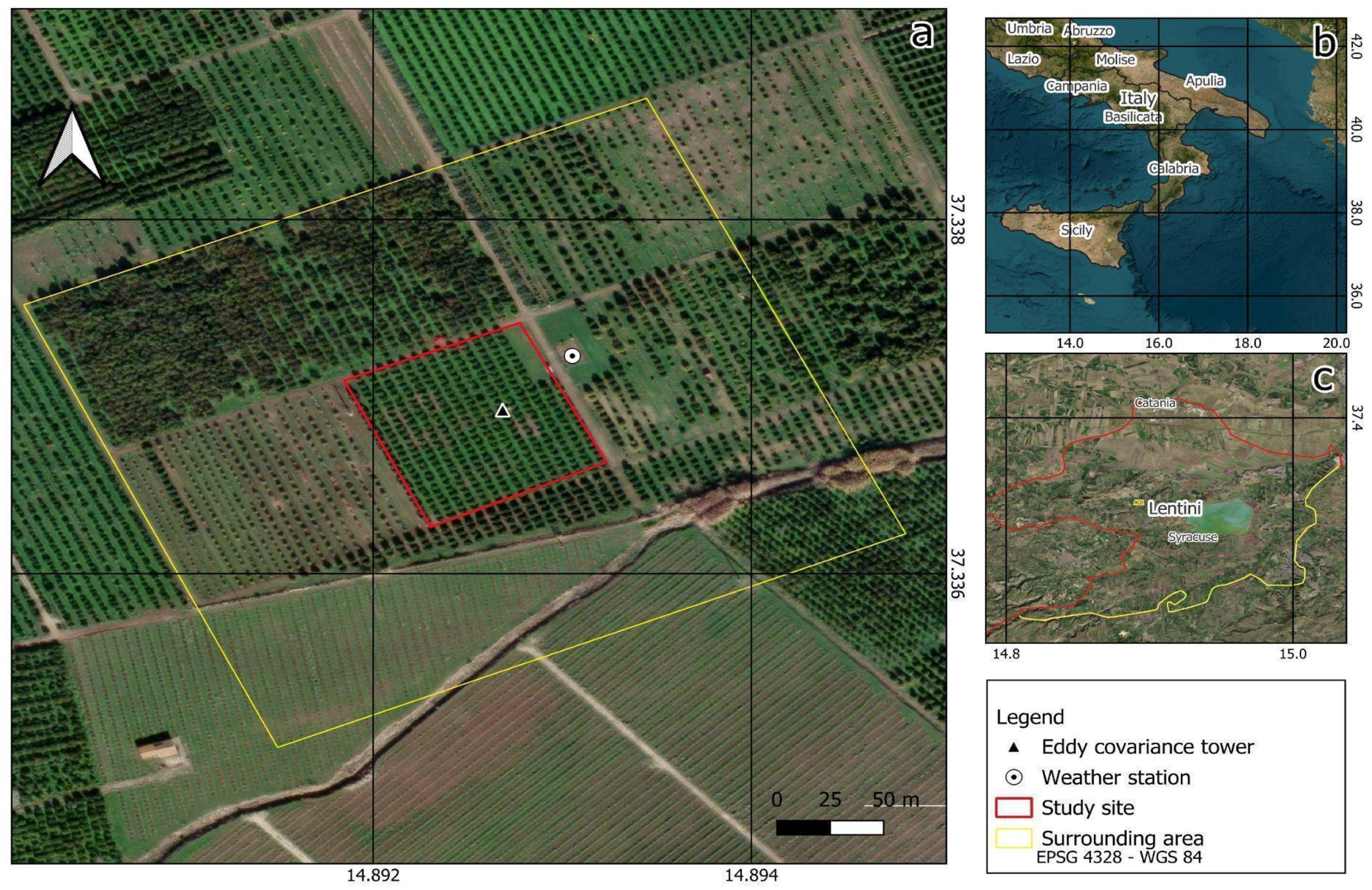
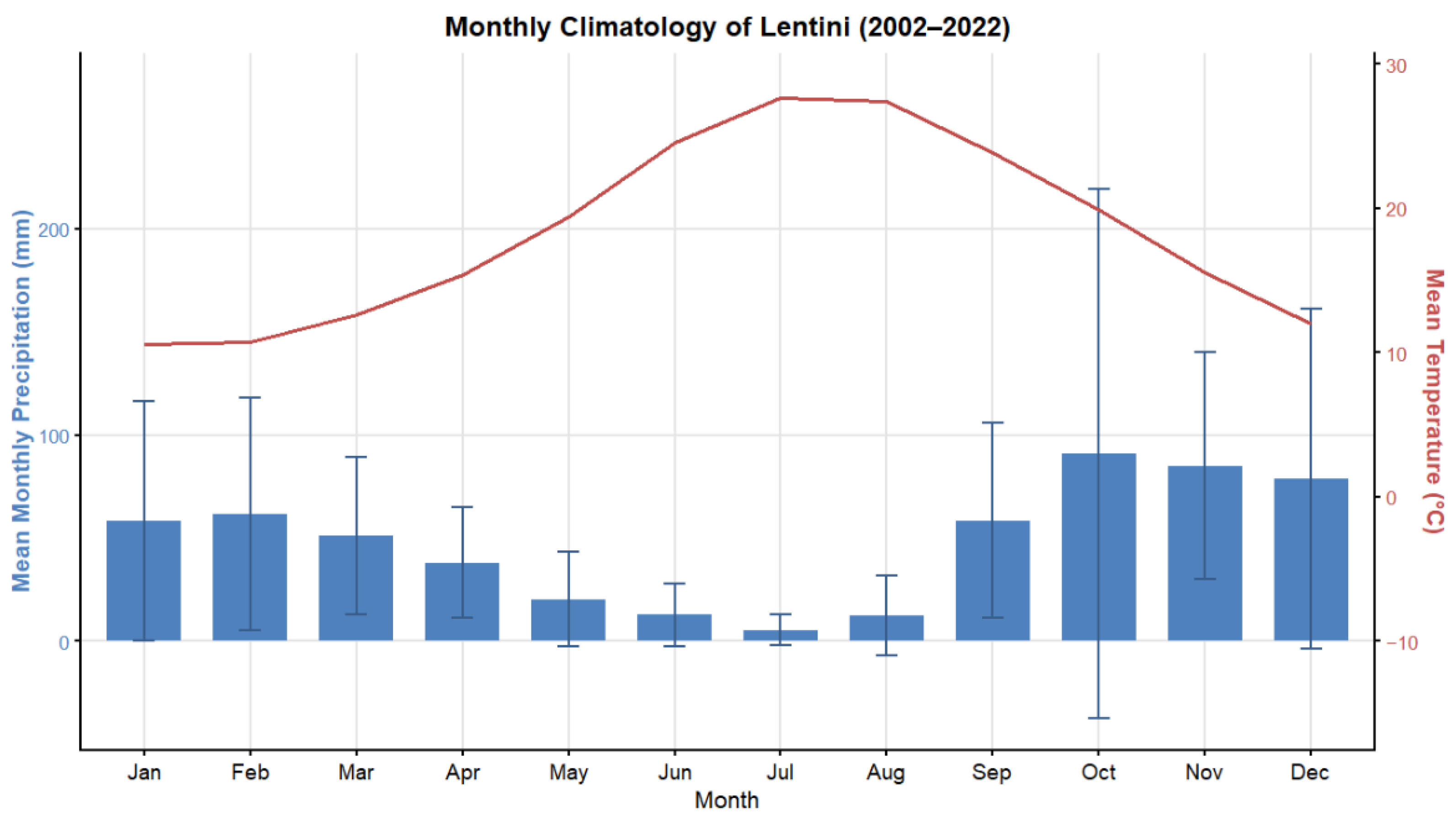
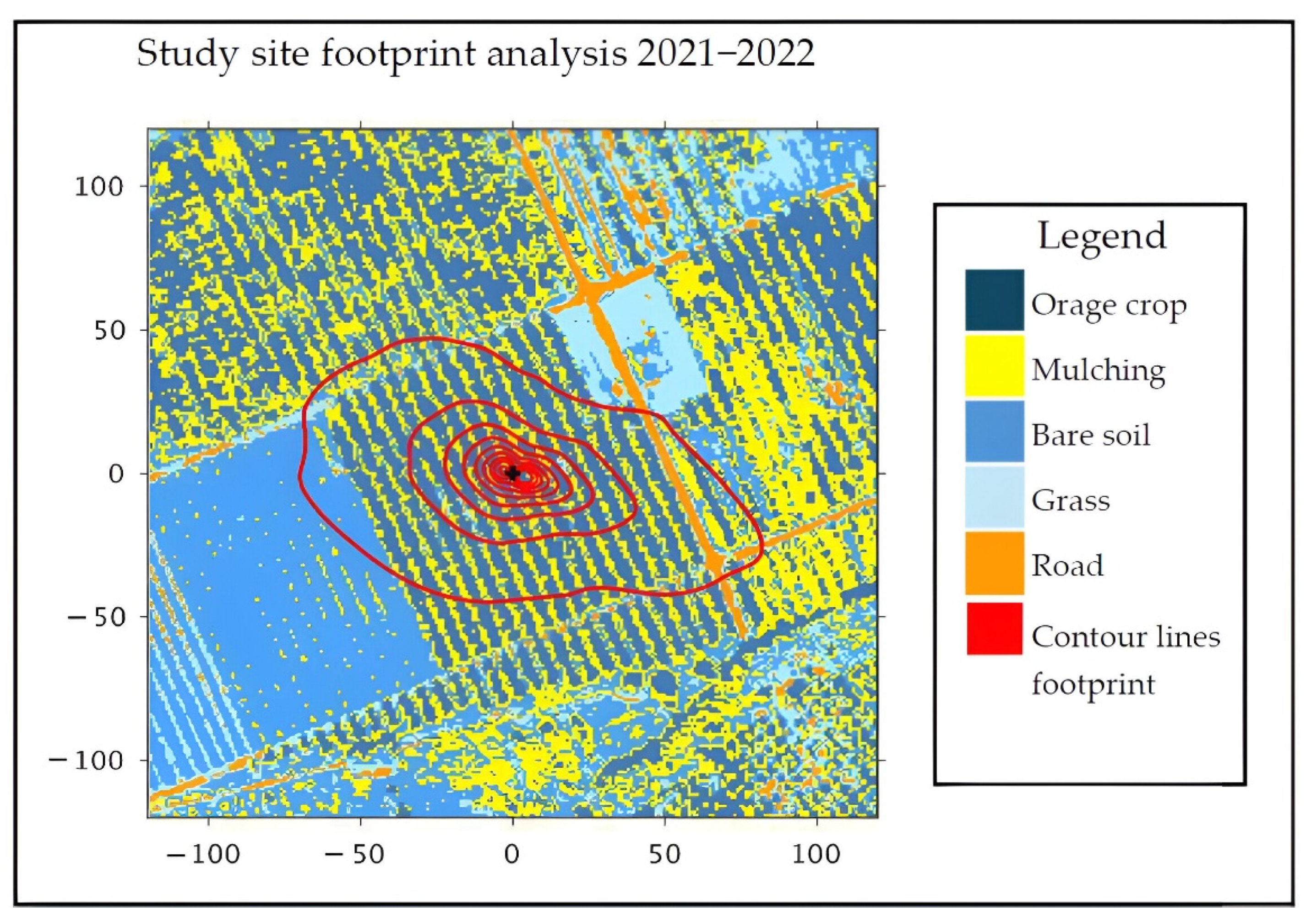
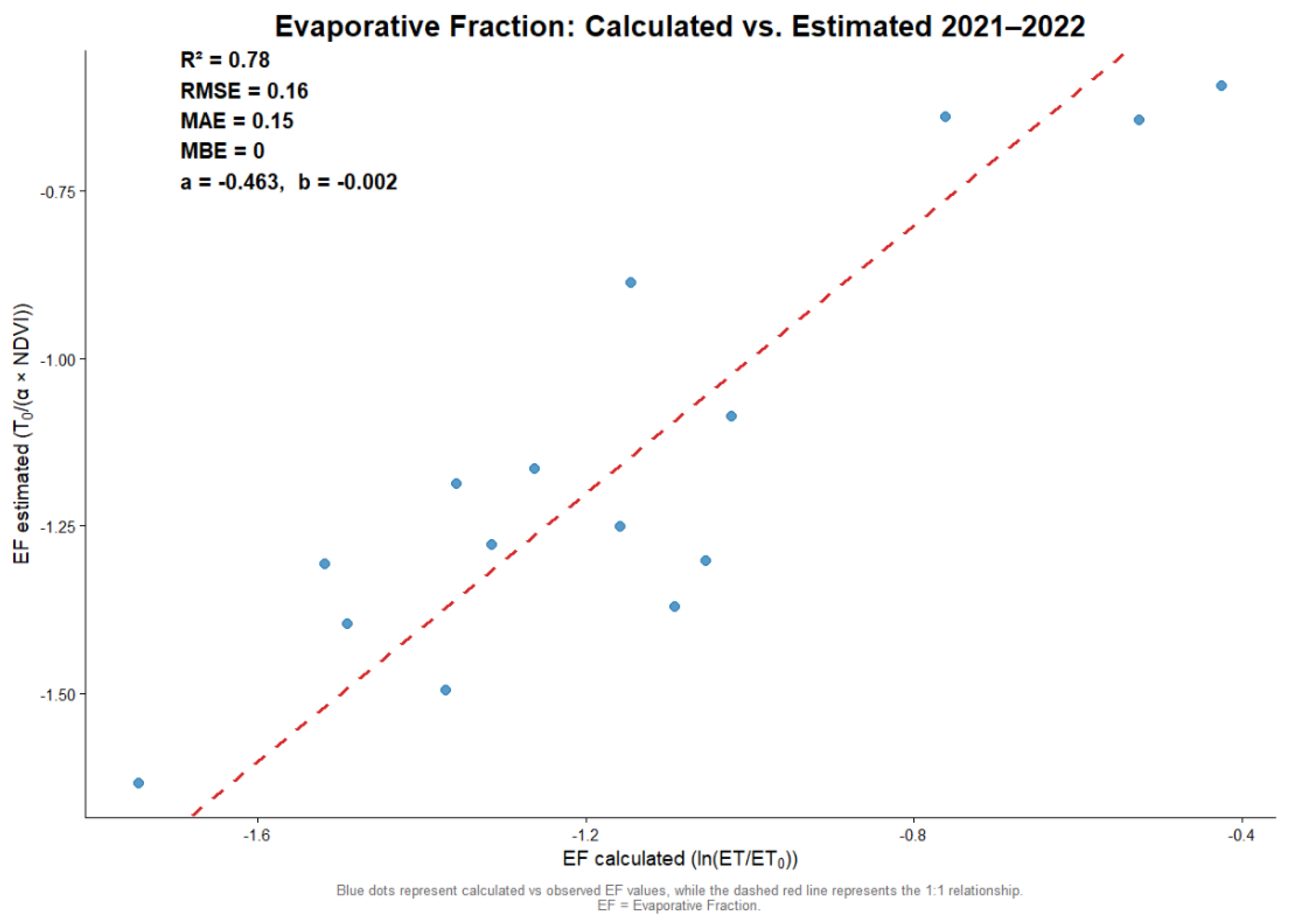
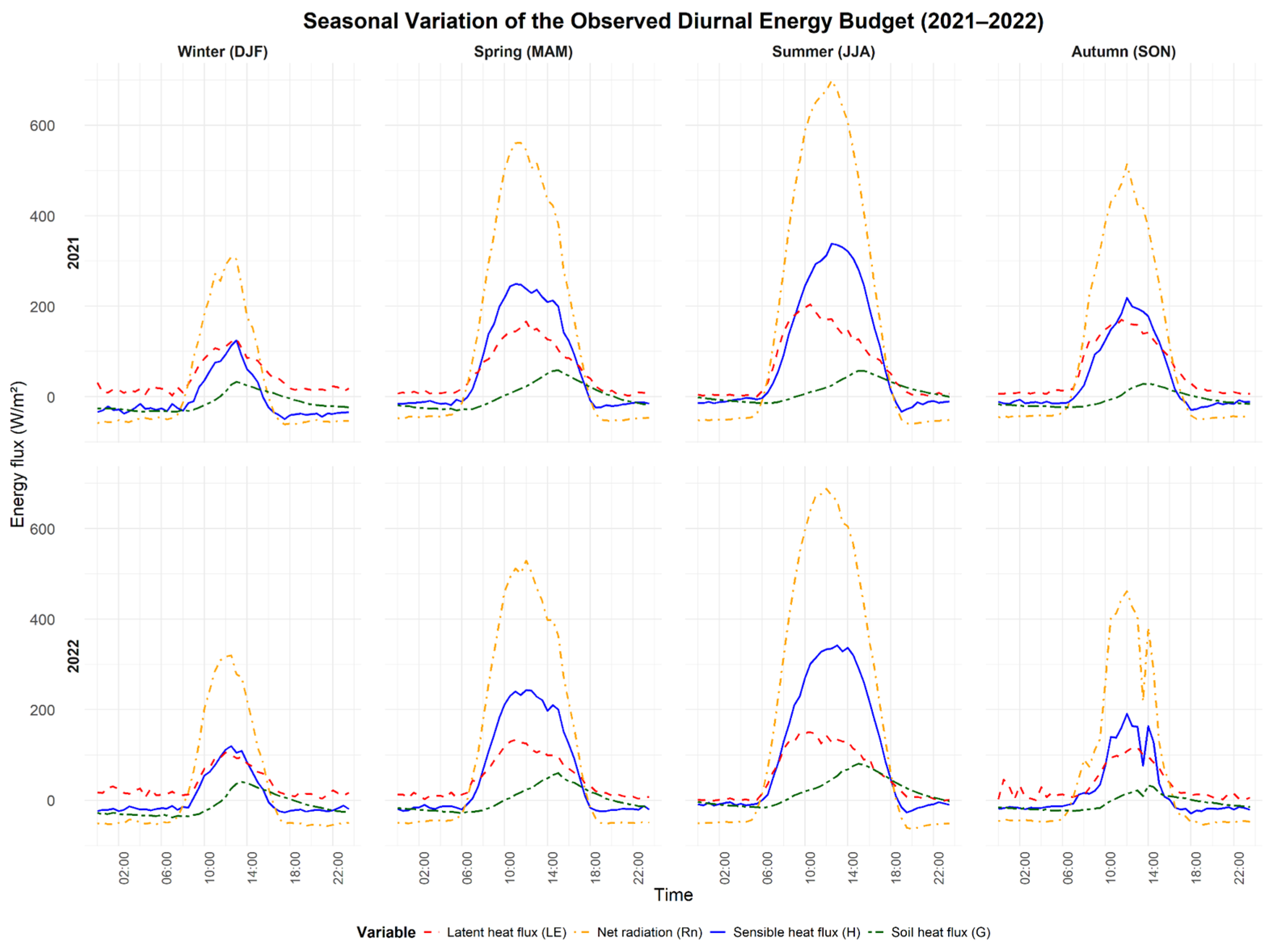
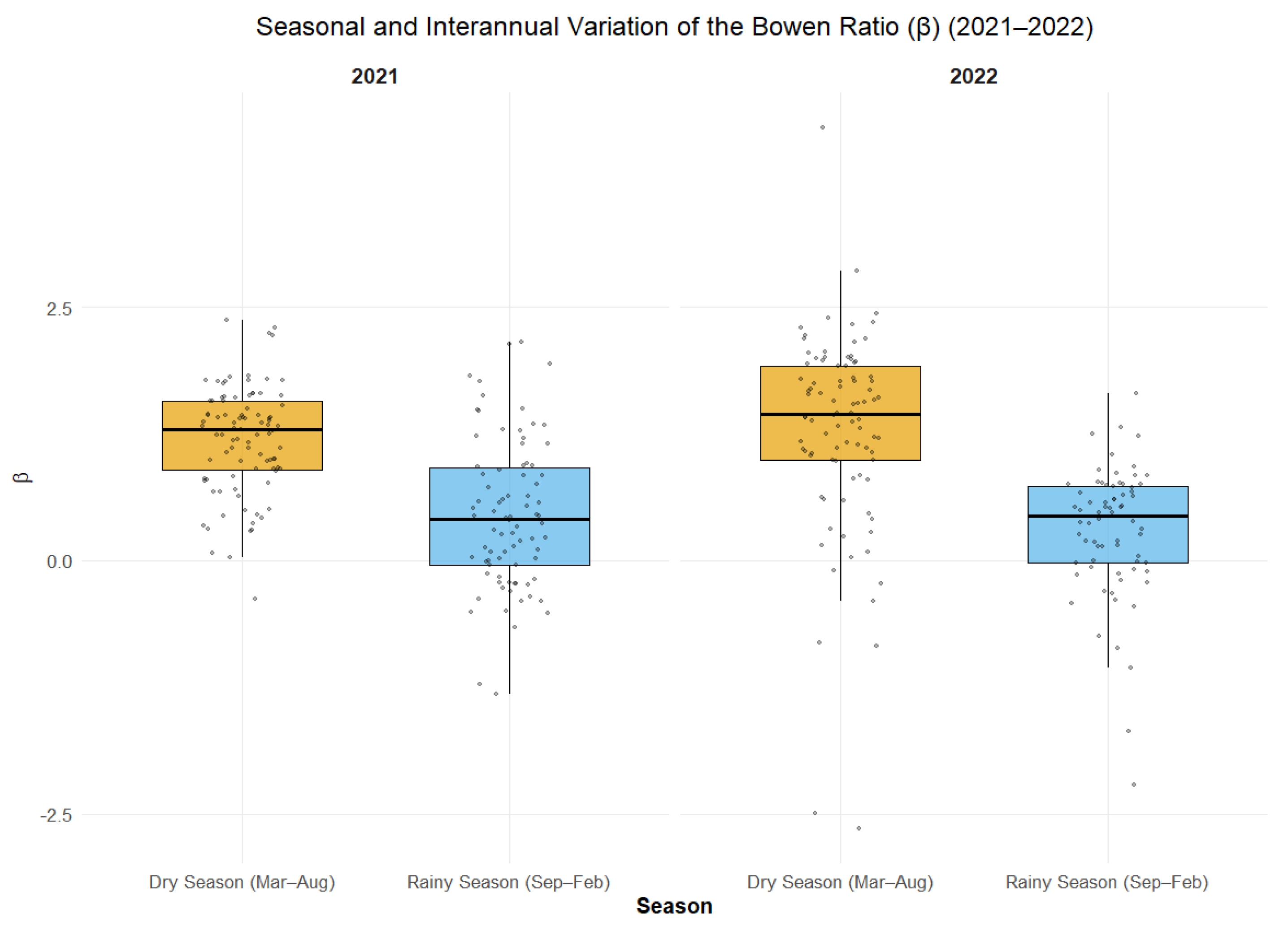
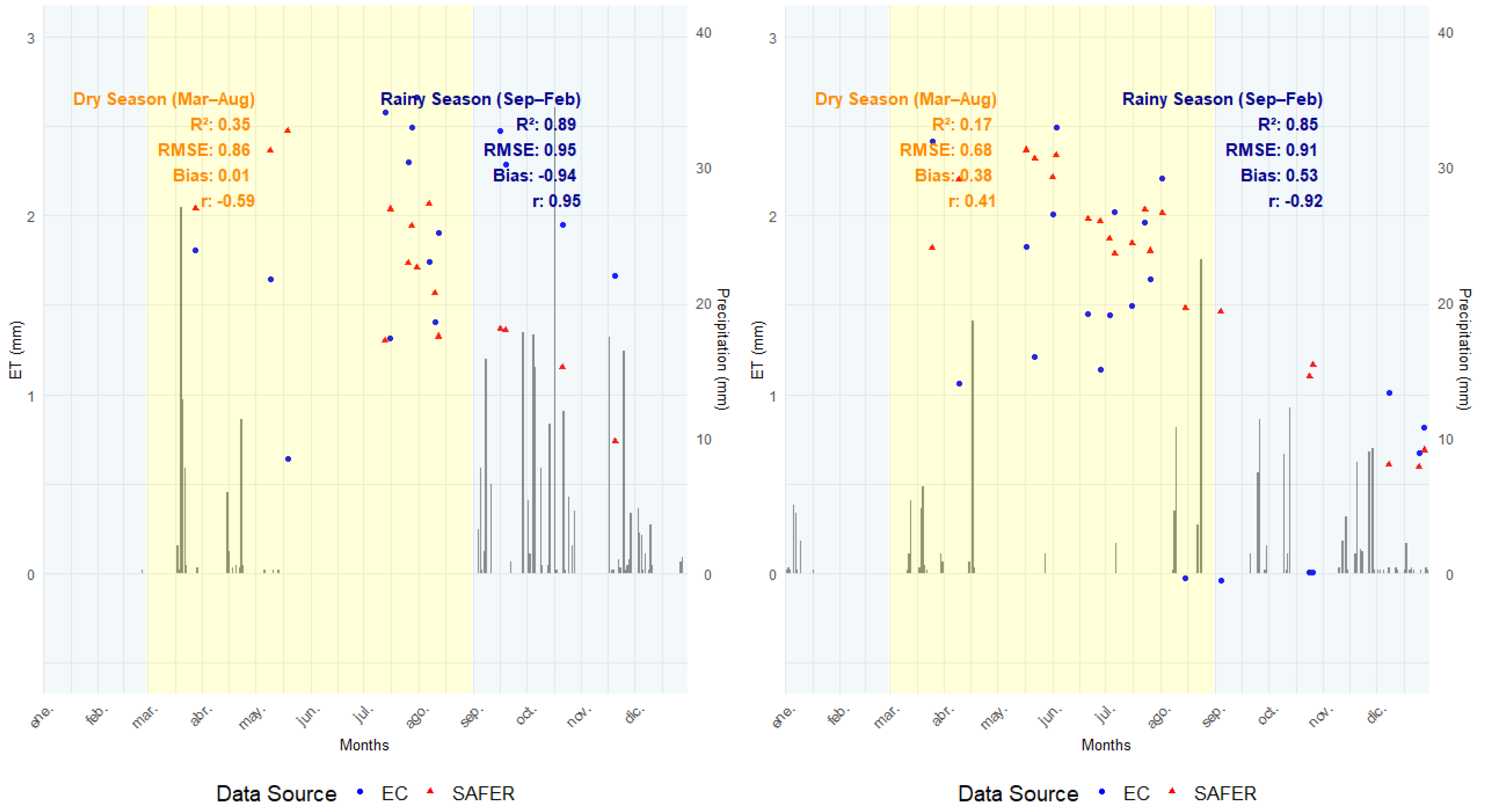
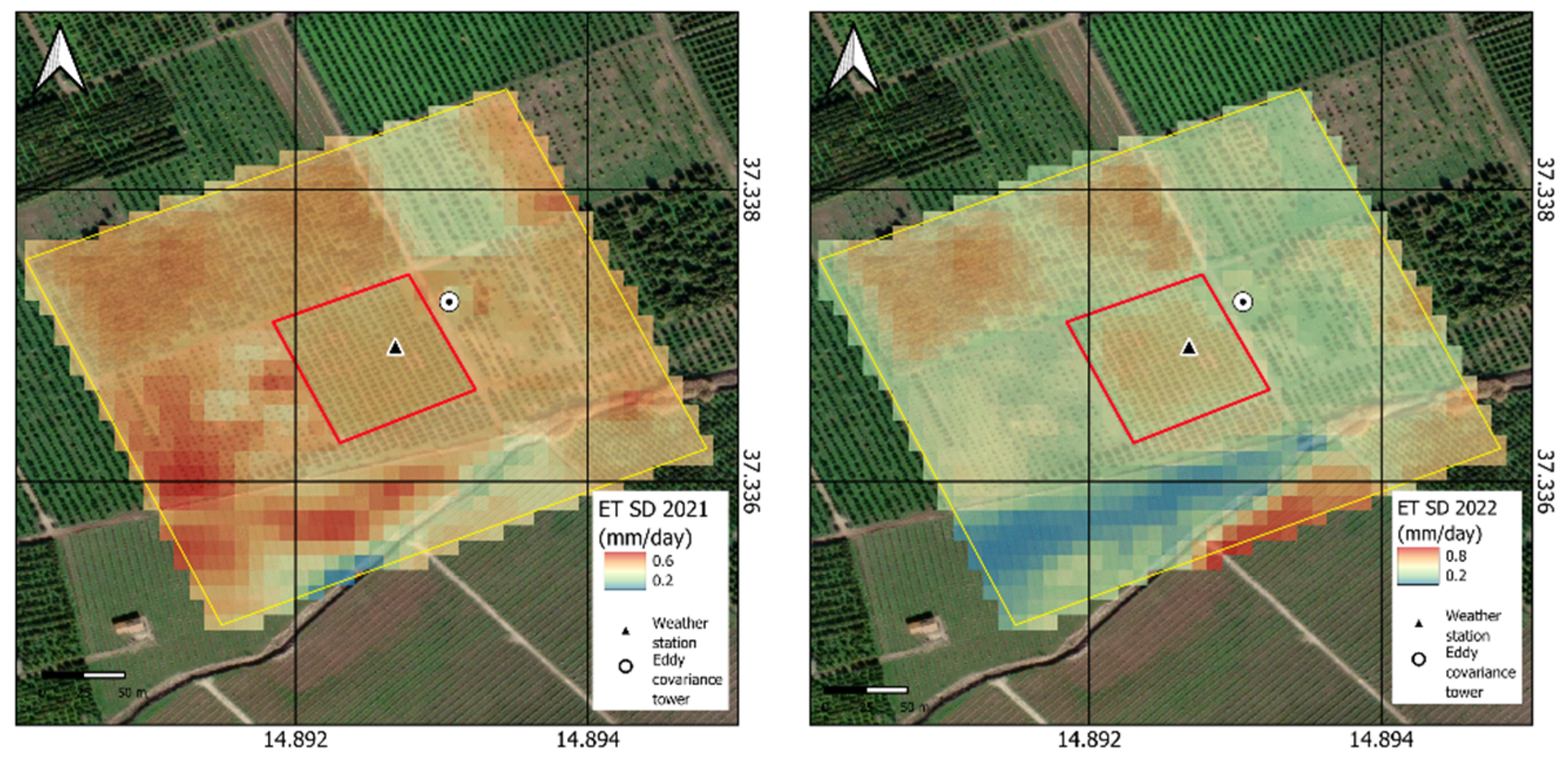
| Year | 2021 | 2022 | |||||||||||||
|---|---|---|---|---|---|---|---|---|---|---|---|---|---|---|---|
| DOY | 87 | 207 | 137 | 209 | 219 | 222 | 152 | 154 | 187 | 197 | 204 | 207 | 214 | 359 | 362 |
| Year | DOY | |||||||||||||||||||||
|---|---|---|---|---|---|---|---|---|---|---|---|---|---|---|---|---|---|---|---|---|---|---|
| 2021 | 87 | 129 | 139 | 194 | 197 | 207 | 209 | 212 | 219 | 222 | 224 | 259 | 262 | 294 | 324 | |||||||
| 2022 | 84 | 99 | 137 | 142 | 152 | 154 | 172 | 179 | 184 | 187 | 197 | 204 | 207 | 214 | 227 | 247 | 297 | 299 | 342 | 359 | 362 | 362 |
| Season | Year | n Days | R2 | RMSE | MBE | r |
|---|---|---|---|---|---|---|
| Dry | 2021 | 11 | 0.35 | 0.86 | 0.01 | −0.59 |
| Rainy | 2021 | 4 | 0.89 | 0.95 | −0.94 | 0.95 |
| All | 2021 | 15 | 0.18 | 0.88 | −0.25 | −0.42 |
| Dry | 2022 | 15 | 0.17 | 0.68 | 0.38 | 0.41 |
| Rainy | 2022 | 6 | 0.85 | 0.91 | 0.53 | −0.92 |
| All | 2022 | 21 | 0.38 | 0.75 | 0.42 | 0.62 |
Disclaimer/Publisher’s Note: The statements, opinions and data contained in all publications are solely those of the individual author(s) and contributor(s) and not of MDPI and/or the editor(s). MDPI and/or the editor(s) disclaim responsibility for any injury to people or property resulting from any ideas, methods, instructions or products referred to in the content. |
© 2025 by the authors. Licensee MDPI, Basel, Switzerland. This article is an open access article distributed under the terms and conditions of the Creative Commons Attribution (CC BY) license (https://creativecommons.org/licenses/by/4.0/).
Share and Cite
Salamanca Lopez, K.A.; João, G.A.; Acioli Imbuzeiro, H.M.; Vanella, D.; Consoli, S.; Longo Minnolo, G.; Pires, G.F.; Oliveira-Júnior, J.F.d. Evaluating a Simple Algorithm for an Evapotranspiration Retrieval Energy Balance Model in Mediterranean Citrus Orchards. Water 2025, 17, 3286. https://doi.org/10.3390/w17223286
Salamanca Lopez KA, João GA, Acioli Imbuzeiro HM, Vanella D, Consoli S, Longo Minnolo G, Pires GF, Oliveira-Júnior JFd. Evaluating a Simple Algorithm for an Evapotranspiration Retrieval Energy Balance Model in Mediterranean Citrus Orchards. Water. 2025; 17(22):3286. https://doi.org/10.3390/w17223286
Chicago/Turabian StyleSalamanca Lopez, Kevin Alain, Gila Abílio João, Hewlley Maria Acioli Imbuzeiro, Daniela Vanella, Simona Consoli, Giuseppe Longo Minnolo, Gabrielle Ferreira Pires, and José Francisco de Oliveira-Júnior. 2025. "Evaluating a Simple Algorithm for an Evapotranspiration Retrieval Energy Balance Model in Mediterranean Citrus Orchards" Water 17, no. 22: 3286. https://doi.org/10.3390/w17223286
APA StyleSalamanca Lopez, K. A., João, G. A., Acioli Imbuzeiro, H. M., Vanella, D., Consoli, S., Longo Minnolo, G., Pires, G. F., & Oliveira-Júnior, J. F. d. (2025). Evaluating a Simple Algorithm for an Evapotranspiration Retrieval Energy Balance Model in Mediterranean Citrus Orchards. Water, 17(22), 3286. https://doi.org/10.3390/w17223286








